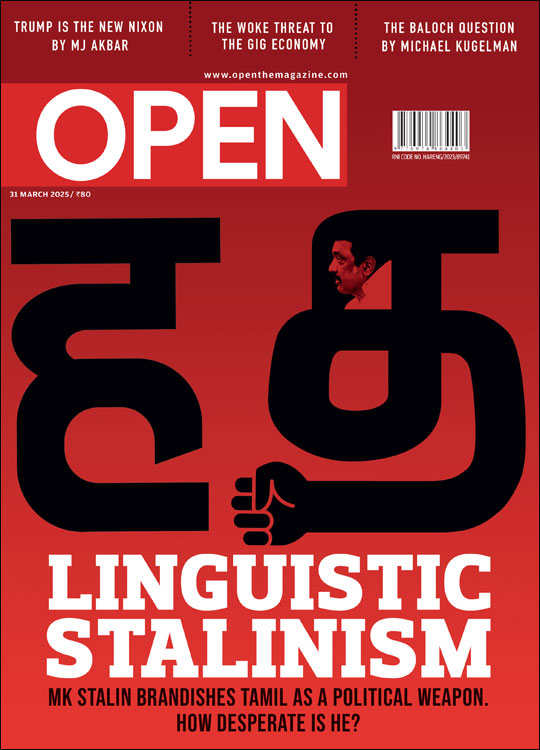100lb Guerillas
Slightly built they may be, but you’d be a fool to take them lightly. Battle-hardened, fiercely committed to their cause and proud of the identity the movement gives them, the woman Maoists here are every bit as fierce as their male comrades.
 Rahul Pandita
Rahul Pandita
 Rahul Pandita
Rahul Pandita
 |
16 Sep, 2010
|
16 Sep, 2010
/wp-content/uploads/2015/11/guerillas1.jpg)
Slightly built they may be, but you’d be a fool to take them lightly. Battle-hardened, the woman Maoists here are every bit as fierce as their male comrades.
DANDAKARANYA: In a largish clearing of forest along a flooded river, somewhere on the Maharashtra-Chhattisgarh border, Maoist commander Tarakka sits on a large boulder, wearing a shirt and bottle-green pyjamas. She is cleaning her AK-47 assault rifle with a toothbrush dipped in kerosene oil. The roar of the river is deafening, with the incessant nocturnal buzz of insects giving the air an eerie edge. The Maoist camp is also home to poisonous snakes, deadly looking spiders, wild pigs, even bears. An hour ago, they killed a huge snake with another snake in its mouth. “The police doesn’t come here,” Tarakka says with a smile, “They know they will be slaughtered.”
“By the way, did you try that karela [bitter gourd] chutney? I made it,” she adds, as she fits the magazine to her gun. It goes in with a distinct click.
Around her, a platoon of Maoist guerillas—mostly young men and women—goes about the daily grind with surgical precision. Men help cook while women go around with axes to chop firewood. Water is boiled to make it safe for drinking. In one corner, a few guerillas have returned after sentry duty at night and are fast asleep on a jhilli (thin plastic sheet). Some girls are reading to each other, while two comb their hair, listening to Gondi songs on a small tape recorder. In another tent, a class is being held on military strategy. In a corner, a bunch of guerillas from the Maoists’ cultural troupe are rehearsing for a performance. No matter what you are doing, the gun always stays next to you, always less than an arm away.
In the monsoons, life becomes quite tough here. We have arrived at the camp after walking for days through dense forests, wading through rivers and nallahs overflowing with rainwater. It is lush green no matter where you look, and with continuous rains, it feels like Vietnam. For the night, we stay in tents or in small isolated huts of Adivasis on the outskirts of some village. We just sigh in the darkness; somebody lets out a cough, and somebody else takes out a tube of mosquito repellent and rubs yet another coat all over his body.
A night before arriving at the camp, we have halted at an Adivasi hut along with the Maoist squad. Under the influence of mahua, or maybe in spite of the intoxicant, the Adivasi begins to cry after some time as he forces a few morsels of rice down his throat.
“Why are you crying?” Maoist squad leader Samayya asks him in Gondi.
“I feel like crying,” he replies.
IN THE WILDERNESS
The next afternoon, we reach the Maoist camp. This is to be our home for the next few days—till further orders. The orders, they keep coming all the time, from all over. Suddenly, anytime of the day or night, a squad of armed guerillas appears and Comrade Narmada, 48, a veteran who has spent 30 years in these jungles, breaks away politely from us to receive news or instructions. Maoist squads are always on the move, and in their area of influence, they move almost freely, without worrying about falling into a police ambush. The last time the police came around to a village neighbouring the camp was about two years ago, we are told.
Whenever Maoists establish a camp, it’s a spectacle for villagers around the area; they keep their necks craned for a look. Here too, a few Adivasis have assembled on the border of the camp area. My friend Vanessa, a French journalist with us, tries speaking to them in broken Hindi that Narmada translates into Gondi. Vanessa is keen to know if there is any school around and if a teacher ever takes classes there.
Narmada translates her question. There is silence for a few seconds. Then one of them, Dolu, starts laughing. He can’t stop. And when he finally does, he does abruptly, almost as if he has clenched his throat. “Guruji!” he speaks with the same wonder with which he utters “Dilli”. “Guruji, he comes every year on 15 August, Jhanda phehraate hein (unfurls the flag) and that is it. We never see him again,” he says, almost astonished at why anybody should ask him about the school teacher, as if this is what school teachers are supposed to do anyway.
A young woman—a child suckles her breast—walks over and kicks a mongrel. It runs away, whimpering, taking refuge beside two Maoists who sit on their haunches on one side.
It makes me wonder: is there a difference between the treatment meted out to mongrels and Adivasis around here? Kicked by the woman, the mongrel ran to the Maoists. Kicked by the State, do these Adivasis have a choice?
TARAKKA’S REBELLION
Ageing villagers across Gadchiroli recount their experiences. This is the district in Maharashtra that Maoist rebels entered back in 1980. At that time, the exploitation of Adivasis was at its peak. Forest officers, big-town businessmen and contractors would fleece them as a matter of routine. Wily traders introduced their diets to salt, and in exchange for 1 kg of it, they would take a kilogram of dry fruits from them. A social activist who works in this area recalls how a forest officer had collected1 lakh in three months from Adivasis living in crushing poverty in lieu of letting them stay in the jungle or collect firewood and other free resources of the forest. In connivance with tendu leaf and bamboo contractors, these officers would make them work on plantations for a pittance. To top it all, there was also sexual exploitation of Adivasi girls.
This injustice was what prompted Tarakka not to heed her parents’ warning and go to the riverside in her village in Gadchiroli where Maoist rebels had put up a camp in the early 1980s. Initially, the villagers had feared that the rebels were dacoits and would loot them of their belongings. Finally, when no one would approach them, the rebels caught hold of a village boy and explained their aim and agenda to him. The word spread
Tarakka says that forest officers would come to her house every year for rice and jowar. “‘Why are we giving them this?’ I would ask my father,” she recalls, “but he would just ask me to keep quiet.” Ultimately, she went secretly to the riverside and met a senior Maoist leader she calls Shankar anna. She was 15 then. By 1986, a few years later, she had joined the rebels full-time. Her first military action was in 1993 when her squad attacked a police post. The last time she saw action, she says, was in 2008 when their camp came under police fire.
But Tarakka’s name figures prominently in the October 2009 attack on police personnel in Gadchiroli’s Laheri area in which 17 policemen lost their lives. A news report in a prominent newspaper refers to Tarakka as the leader of the attack, calling her ‘a woman known not just for her commitment to the ‘Naxalite cause’ but also her beauty’. When the report is cited, she smiles with an almost girlish delight. “No, I was not in the group that attacked policemen in Laheri,” she says, fiddling with her gun.
While Tarakka feels free to talk about her reasons for entering the Maoist fold, most of the younger lot shy away from discussing it, often citing constraints of language. Even when leaders who can speak Gondi and then translate it into Hindi or English offer to play interpreters, not much can be heard from the younger guerillas, especially the girls.
It is futile asking them why they joined, just as it is futile asking Adivasis what they would want in terms of a
better life. The younger lot have no specific answer on why they joined the Naxal rebellion.
After a few years of political instruction by higher-ups, they might bring themselves to utter phrases such as “class struggle” or “peasant insurrection”, or raise their fists in a defiant ‘red salute’, but mostly it is because of the lure of battle fatigues. It offers them a sense of group bonding, a sense of who they are, and some purpose in life.
SEARCH FOR IDENTITY
As for a better life, over years and years of such jungle visits, I have come to realise that the typical Adivasi has no reference point for such an aspiration. Having been left in the lurch like this by the rest of India, filling their bellies is the main idea. Two villagers died of diarrhoea just a week before our arrival at the village next to the Maoist camp. The villagers grow paddy, but in the absence of proper knowledge, the crop often falls victim to disease. To avoid this, Adivasis use the services of a vadde—local witch doctor—to perform a dev puja. The paddy they grow is not enough to feed them. So their staple diet is rice gruel. The nearest ration shop is about 20 km away. “But by the time we come to know that rations have come, it is already over,” says a villager. Many have run away to work as labourers in Bombay and Pune.
The villagers also have ties with Maoists. In the absence of the State, it is the guerillas who they rely on for help in small ways. Villagers often dine with them at the camp. Maoist medical teams also distribute medicines, including anti-malaria and anti-venom vaccines, among villagers. Unsurprisingly, some end up joining them. Like 14-year-old Suresh, who is now part of Chetna Natya Manch, the CPI (Maoist) cultural troupe. “We dissuaded him from joining us at such a young age, but he followed us for weeks,” says his team leader Raju.
Suresh used to attend a local paathshala (school) run by the Tribal Affairs Ministry. “But the food there was so bad and erratic, I ran away,” he says. Suresh has returned to his village after months, since he travels with the troupe from one village to another. His mother has come to meet him. “I ask him to come back,” she says, “but he refuses.”
The Maoist cause gives Suresh a sense of identity. The work and guns of his senior comrades give him a purpose in life.
It is the same sense of identity that stops another young boy from taking off his cap. It is olive green with a star. On its tip, he has scribbled the name given to him by the party: Viju. “Some comrades who knew his original name would call him by that, and he would get upset,” says another guerilla. “That is why he wrote ‘Viju’ over that cap.”
In the camp, Viju has fallen asleep. Narmada, who is the political head of the Gadchiroli division, looks at Viju lovingly and asks her bodyguard to pull a sheet over him for warmth. “From wearing saris to donning military fatigues like men, we women comrades have come a long way,” she says. In a check shirt and loose trousers, with short hair, Narmada is hardly distinguishable from the rest of the platoon. She has just arrived at the camp five days ago after crossing a dirty nallah. This has led to a severe allergy all over her body.
Narmada comes from Andhra Pradesh and joined the Maoist movement when she was 18. “My father was a Communist, and in those times, a Communist was like a pariah. My father would talk about Naxals and say that they have broken away from the shackles of domesticity,” she says. It was then, she says, that she made up her mind to join the Naxals. Today, she frames all policies for the female cadre of Maoists. Inside the camp, Narmada pops pills silently, as she goes about writing and discussing military strategy with Commander Eiatu, the military head of the Gadchiroli division.
When the whistle blows, both of them take out their steel plates and go to get food from the kitchen—mostly rice and dal. When guests arrive (in this case us), there might be eggs or an occasional chicken cooked without wasting any body part, not even the intestines.
Narmada’s bodyguard is a young girl, Sunita, who, with her cropped hair, looks like an LTTE militant. She hardly smiles, and even while she eats, her AK-47 rests against her knee. In contrast, her friend Rummy, who likes to sing revolutionary songs about fallen comrades, smiles easily. All of them can read and write—and assemble a gun in seconds. During patrols, they move about stealthily and reputedly attack with ferocity.
The CPI (Maoist) has an open policy about relationships. A man can marry a woman comrade with mutual consent. There have been stories of a Maoist squad coming under fire and a husband-wife duo staying behind together to engage the police, sacrificing their lives jointly to let others flee to safety. Another girl, Surekha, shows us her kit which includes a hand grenade. Has she ever taken part in action? We ask. She doesn’t say anything. Later, a senior Maoist confirms that she indeed has, and in some of the most deadly encounters.
THE WAR OUT THERE
Commander Eiatu’s brother, a senior leader, was allegedly killed in a fake encounter along with his partner in 2008; another brother is also a Maoist commander. Eiatu’s partner works with the Maoists’ doctor brigade. “We meet sometimes,” he says.
Later that night, Eiatu offers us glimpses of the military planning that went into the Laheri attack he had led. “Just before the Assembly election, the police had created fear in village after village to coerce people into submission,” he says. One day, their platoon of Maoists got information that a team of police commandos, led by their leader Rama, was moving in the area. For two days, the guerillas followed them, without as much as stopping for food. Finally, hostilities broke out at Laheri in Bhamragarh taluka, just 750 yards away from the Laheri police station. Some 42 policemen and 18 Maoist guerillas (who’d reached before their other exhausted comrades) found themselves locked in a fierce gunbattle. “The police have a lot of ammunition,” generalises Eiatu, “and they just lay on the ground, firing thousands of rounds all over. But since we have limited ammunition, we fire at specific targets.”
The policemen, Eiatu says, kept shouting that the guerillas would be mowed down since police enforcements were coming, but they held their ground—and upped the ante. For the first 30 minutes, nobody was injured on either side. Then, in the next ten minutes, six policemen were killed. After this, Eiatu claims, most policemen fled, including their leader. Eight policemen who had taken positions at one particular spot were asked to surrender. “But they let out another volley of bullets in which our senior comrade was killed,” says Eiatu. After this, the guerillas let their guns blaze—killing eight of them and three others. In all, 19 weapons were seized in that encounter. That also explains the extraordinary extent of modern weaponry I saw in the platoon’s possession. In five major engagements over the past 18 months, Maoists have been able to snatch as many as 77 guns—mostly AK-47 and Insas rifles—from security forces in Gadchiroli district alone.
It’s message time again. Everyone looks up. We cannot move further, it seems—all the rivers are in spate. (Later when we return, we learn of the death of senior Maoist leader Ganesh Uike who had malaria and could not be taken to a hospital in Bastar because of floods.) It is just too tough to embark on our return now. Roads are cut off. We are left stranded in a small village for three days. On the last day, we finally gather the courage to take a small boat across an angry river.
On the last night in the jungle, a writer who is with us, and has left his ailing mother behind, wakes up suddenly and cries: “Mother, I am coming.” I tell Samayya this and we smile. “Yes, mothers can do that to you,” he says. “Ho,” he nods his head. Ho means yes. Yes.

/wp-content/uploads/2025/03/Cover-Tamil.jpg)











More Columns
Cong Fetish for Muslim Quota Roils Parliament Siddharth Singh
“Majority of Jews in US universities oppose what Israel is doing to Palestinians” Ullekh NP
Flights of Fancy Shail Desai